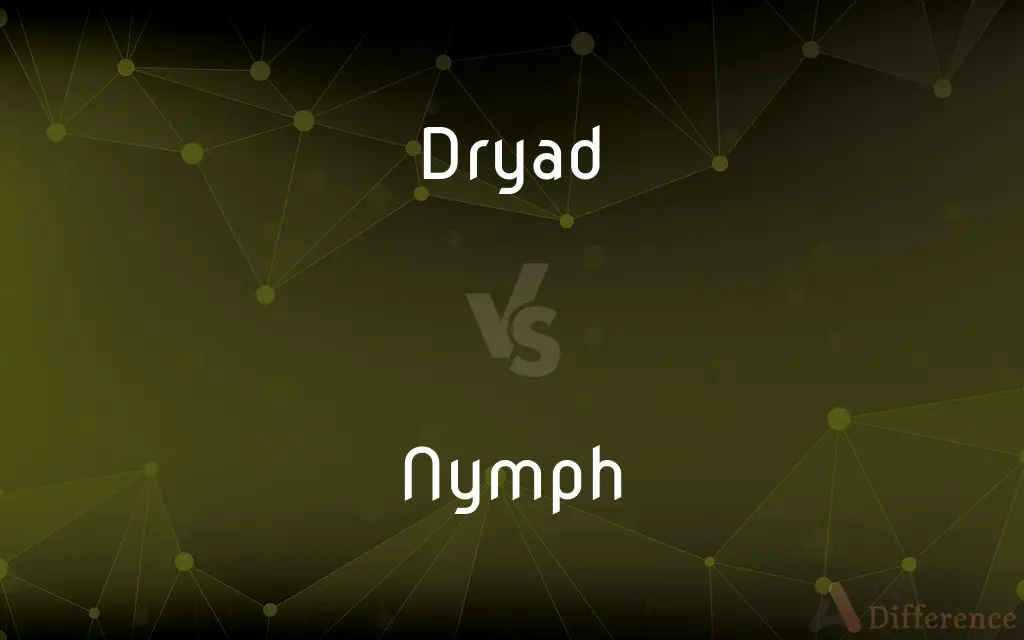Dryad vs. Nymph — What's the Difference?
By Tayyaba Rehman & Fiza Rafique — Updated on April 18, 2024
Dryads are tree-associated nymphs in Greek mythology, bound to specific trees, while nymphs are broader minor deities linked with nature's various elements.

Difference Between Dryad and Nymph
Table of Contents
ADVERTISEMENT
Key Differences
Dryads are a specific type of nymph in Greek mythology, closely tied to trees, often those of oak or pine. Nymphs, on the other hand, are a broader category of mythological beings associated with natural features such as mountains, forests, water bodies like rivers and seas, or even certain abstract locales.
Each dryad is born with and linked to a particular tree, and their life force is connected directly to that tree’s health and longevity. Unlike dryads, nymphs aren't typically bound to specific natural elements but interact with them more freely.
In literature and mythology, dryads are portrayed as shy and reticent, reflecting their deep, singular bond with their respective trees. Their stories often focus on their interactions with their tree and the immediate surrounding forest. Nymphs are depicted as more sociable and dynamic, engaging with gods, humans, and other creatures of mythology. Their narratives are more varied, involving adventures or roles that span across different parts of nature.
The vulnerability of dryads is distinct in mythological stories; harm to their associated tree directly affects their well-being and can lead to their death, emphasizing their ecological symbolism. Nymphs, while also emblematic of the natural world's vitality and fragility, do not share this direct dependency. They embody the spirit of their respective realms more generally and are not as susceptible to individual environmental impacts.
Comparison Chart
Definition
A tree spirit or deity in Greek mythology, linked to a specific tree.
A broad category of minor deities associated with various natural elements.
ADVERTISEMENT
Bond
Tied to a specific tree; their life and health depend on the tree’s condition.
Not typically bound to specific natural elements; more free-roaming.
Mythological Role
Guardians of forests, particularly of their individual trees.
Guardians or spirits of natural elements like water, forests, and mountains.
Social Interaction
Generally depicted as solitary and shy due to their tree-bound nature.
Often depicted as sociable, interacting with gods and humans.
Symbolism
Symbolizes the intimate and direct connection between living beings and their environment.
Represents the overarching vitality and spirit of nature.
Compare with Definitions
Dryad
A mythological spirit that personifies a tree.
The dryad of the pine was said to whisper with the wind.
Nymph
A spirit of nature often depicted in ancient myths.
The river’s nymph could calm the turbulent waters with a mere gesture.
Dryad
A symbol of ecological interdependence and vulnerability.
The dryad's fading strength was an ominous sign of the forest's health.
Nymph
A creature with the ability to interact freely across various natural realms.
The nymph moved from the shadowy forest to the sunny glade with ease.
Dryad
A creature from Greek mythology associated with the forest.
Tales of the forest's dryad were common among the local woodcutters.
Nymph
A deity representing broader natural elements like water, forests, or mountains.
The mountain nymph was revered by the villagers living at its base.
Dryad
A nymph inhabiting and spiritually bound to a tree.
The ancient oak’s dryad mourned silently as the tree was felled.
Nymph
A symbol of natural beauty and grace.
Artists often depicted nymphs to embody the beauty of nature.
Dryad
A guardian of a specific tree in folklore.
The village children were told not to harm the trees, lest they anger the dryad.
Nymph
A playful and important figure in Greek mythology.
The nymphs danced through the woods, drawing the attention of passing travelers.
Dryad
A dryad (; Greek: Δρυάδες, sing.: Δρυάς) is a tree nymph or tree spirit in Greek mythology. Drys signifies "oak" in Greek, and dryads are specifically the nymphs of oak trees, but the term has come to be used for tree nymphs in general, or human-tree hybrids in fantasy.
Nymph
A nymph (Greek: νύμφη, nýmphē; Ancient: [nýmpʰɛː], Modern: [nímfi]) in ancient Greek folklore is a minor female nature deity. Different from Greek goddesses, nymphs are generally regarded as personifications of nature, are typically tied to a specific place or landform, and are usually depicted as beautiful maidens.
Dryad
(in folklore and Greek mythology) a nymph inhabiting a tree or wood.
Nymph
A mythological spirit of nature imagined as a beautiful maiden inhabiting rivers, woods, or other locations
The idyllic world of nymphs and shepherds
A wood nymph
Dryad
A dark brown Eurasian butterfly with two prominent bluish eyespots on each forewing.
Nymph
An immature form of an insect that does not change greatly as it grows, e.g. a dragonfly, mayfly, or locust.
Dryad
A divinity presiding over forests and trees; a wood nymph.
Nymph
A mainly brown butterfly that frequents woods and forest glades.
Dryad
(Greek mythology) A female tree spirit.
Nymph
Greek & Roman Mythology Any of numerous minor deities represented as beautiful maidens inhabiting and sometimes personifying features of nature such as trees, waters, and mountains.
Dryad
A wood nymph; a nymph whose life was bound up with that of her tree.
Nymph
The eight-legged immature form of certain arachnids, such as ticks and mites.
Dryad
A deity or nymph of the woods
Nymph
Any female nature spirit associated with water, forests, grotto, wind, etc.
Nymph
A young girl, especially one who is attractive, beautiful or graceful.
Nymph
(entomology) The larva of certain insects.
Nymph
(entomology) Any of various butterflies of the family Nymphalidae.
Nymph
A goddess of the mountains, forests, meadows, or waters.
Where were ye, nymphs, when the remorseless deepClosed o'er the head of your loved Lycidas?
Nymph
A lovely young girl; a maiden; a damsel.
Nymph, in thy orisonsBe all my sins remembered.
Nymph
The pupa of an insect; a chrysalis.
Nymph
Any one of a subfamily (Najades) of butterflies including the purples, the fritillaries, the peacock butterfly, etc.; - called also naiad.
Nymph
(classical mythology) a minor nature goddess usually depicted as a beautiful maiden;
The ancient Greeks believed that nymphs inhabited forests and bodies of water
Nymph
A larva of an insect with incomplete metamorphosis (as the dragonfly or mayfly)
Nymph
A voluptuously beautiful young woman
Common Curiosities
How do dryads differ from other nymphs?
Dryads are specifically bound to trees and their lives are directly connected to the health of these trees, unlike other nymphs who are associated with broader natural elements.
What types of nymphs are there?
There are several types, including naiads (water nymphs), oreads (mountain nymphs), and dryads (tree nymphs).
Can dryads leave their trees?
Typically, dryads are bound to their trees and cannot stray far from them.
What happens if a dryad's tree is destroyed?
If a dryad's associated tree is destroyed, the dryad typically dies or suffers greatly, as their life force is intricately tied to the tree's wellbeing.
What is the cultural significance of dryads and nymphs in mythology?
Dryads and nymphs symbolize the interconnection between nature and the divine, highlighting themes of protection, fertility, and the natural cycles through their stories.
What is a dryad?
A dryad is a tree spirit in Greek mythology, each one linked to a specific tree.
How do artists and writers typically depict dryads and nymphs?
Dryads are often depicted merged with or emerging from trees, symbolizing their connection to their specific tree, whereas nymphs are usually shown as ethereal and beautiful beings, interacting freely with various elements of nature.
Do nymphs interact with humans?
Yes, nymphs frequently interact with humans and gods in mythology, often playing key roles in myths and stories.
Are nymphs immortal in Greek mythology?
Nymphs are considered long-lived or ageless but not strictly immortal; they can be harmed or affected by environmental changes and the actions of gods or mortals.
Can nymphs be male or female?
Most nymphs depicted in mythology are female, representing aspects of fertility and nature’s beauty, though male equivalents, often referred to with different terms, do appear in some myths.
Share Your Discovery

Previous Comparison
Grounds vs. Ground
Next Comparison
License vs. BachelorAuthor Spotlight
Written by
Tayyaba RehmanTayyaba Rehman is a distinguished writer, currently serving as a primary contributor to askdifference.com. As a researcher in semantics and etymology, Tayyaba's passion for the complexity of languages and their distinctions has found a perfect home on the platform. Tayyaba delves into the intricacies of language, distinguishing between commonly confused words and phrases, thereby providing clarity for readers worldwide.
Co-written by
Fiza RafiqueFiza Rafique is a skilled content writer at AskDifference.com, where she meticulously refines and enhances written pieces. Drawing from her vast editorial expertise, Fiza ensures clarity, accuracy, and precision in every article. Passionate about language, she continually seeks to elevate the quality of content for readers worldwide.















































